
Leaving the upper Danube behind us we travelled through one of the most impressive stretches of the Danube, the gorge between the Carpathian and Balkan Mountains. the so-called Iron Gates. Here there are monuments to the Roman Emperor Trajan who built a bridge across the river to conquer what was then the kingdom of Dacia (ruled by Decebalus whose huge statue is carved into the northern cliff face). The gorge is awesome,, and I was so glad that the morning rain cleared to allow us a good view of our passage
By now we were well into territory that was entirely new to us, and we had to keep referring to the map to see which country we were in and to work out where we were going as the town and city names meant nothing to us. Our next country was Bulgaria, and we spent a whole day ashore while the ship travelled on without us. We disembarked at the small town of Svistov and travelled by coach through beautiful countryside to Arbanassi for a rest stop and coffee at a beautiful hillside hotel while the ship headed downstream to wait for us at the port of Rousse.
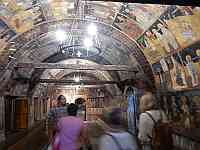 |
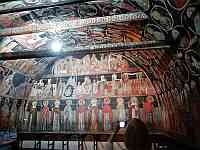 |
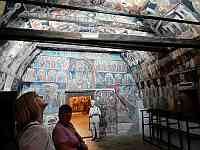 |
The interior of the Nativity Church is amazingly decorated, with illustrations of Bible Scenes and depictions of the Saints and Angels |
||
Veliko Tarnovo had been the capital of Bulgaria in Mediaeval times, After an excellent lunch in a hotel there we visited the market street and bought several hand-made souvenirs to take home and then visited a small church for an impressive performance by a small local choir (but we didn't buy their CD). We then returned to the ship, but there was a slight delay because we were short by one passenger; it transpired that she had got onto the wrong coach at Veliko Tarnovo and had only realised her mistake after half an hour's travel when she noticed that everyone around her was speaking French. Fortunately they were also a tourist group, but from a different cruise ship that was also moored at Rousse and only a quarter-mile from our own ship.
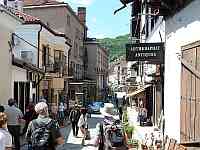 |
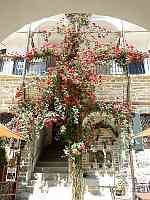 |
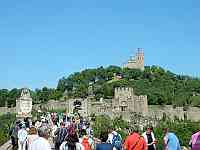 |
The ancient main street at Veliko Tarnovo has a wonderful Artisan market |
A beautifully restored hotel in the Artisan street |
The Tzarevets fortress at Veliko Tarnovo |
The next morning we awoke in Romania. We were docked at the port of Cernavoda which is at the junction with the Black Sea Canal, to take a coach to the Black Sea resort town of Constanta. With its Greek and Roman history to remember, Constanta prefers to forget the period of rule by the Communist dictator Nicolae Ceaucescu - although the massive ruin of his Casino dominates the sea front - which ended in revolution in 1989. Indeed the local museum which we visited, has collated all its exhibits relating to that period on the top floor which is not shown to visitors such as ourselves (and bears no translations on its captions); naturally we found our way to the top floor. Some of these exhibits were horrifying, showing for example the deaths of thousands of people who were conscripted into forced labour in building the Black Sea Canal.
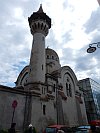 |
 |
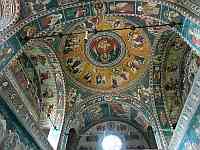 |
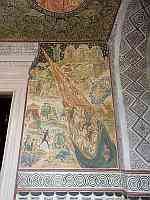 |
Many different religions co-exist in Constanta; this is the Turkish Mosque |
The Catholic Cathedral is typically highly decorated ... |
... both inside ... |
... and outside |
After a brisk walk along the Promenade, we returned to the coaches and boarded the ship for the final stage of our journey down the Danube. The afternoon's lecture on board addressed the question of Brexit, which raised a number of new issues and triggered some interesting debate.
The following morning we rose early to say Hello to the Black Sea, the whole purpose of our trip. The ship sailed to within a couple of hundred yards of the sea itself, but the swell at sea was in excess of 1 metre and so was beyond the safe limit for our flat-bottomed riverboat. This meant that we had to turn about and return past the small fishing village of St George at the mouth of the river, but we were happy to have achieved our objective!
We had just one last destination on the ship before our journey would come to an end. We travelled back up the river to Mila 35 where a derelict lodge that once belonged to Ceausescu still served as a (rather precarious) mooring point. Here we were taken on board a couple of smaller boats that toured the Delta wetlands. The guide was really excited about seeing a heron; we explained that we see them all the time on our boat but were instead quite excited to see wild pelicans.
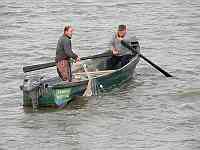 |
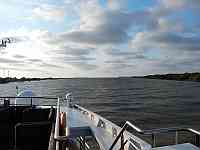 |
There is no town at the mouth of the Danube, just a small fishing village |
Finally we reached the Black Sea, our destination |
At last it was time to leave the ship which had been our home for the last 3 weeks. We drove to the city of Bucharest ("please don't confuse our city with Budapest") and had a magnificent lunch at a hotel there before flying home. It had been a wonderful trip, on a wonderful ship with wonderful excursions to 8 different countries - leaving us with a kaleidoscope of wonderful memories ...
All pictures on this site are © Allan Jones unless otherwise stated